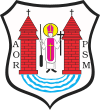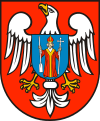Mława
Coordinates: 53°07′N 20°22′E / 53.117°N 20.367°E
| Mława | |||
|---|---|---|---|
|
Air view of Mława | |||
| |||
 Mława | |||
| Coordinates: 53°7′N 20°22′E / 53.117°N 20.367°E | |||
| Country |
| ||
| Voivodeship | Masovian | ||
| County | Mława County | ||
| Gmina | Mława (urban gmina) | ||
| Established | 15th century | ||
| Town rights | 1429 | ||
| Government | |||
| • Mayor | Sławomir Kowalewski | ||
| Area | |||
| • Total | 35.5 km2 (13.7 sq mi) | ||
| Highest elevation | 180 m (590 ft) | ||
| Lowest elevation | 135 m (443 ft) | ||
| Population (2012) | |||
| • Total | 30,957 | ||
| • Density | 870/km2 (2,300/sq mi) | ||
| Time zone | CET (UTC+1) | ||
| • Summer (DST) | CEST (UTC+2) | ||
| Postal code | 06-500 to 06-501 | ||
| Area code(s) | +48 023 | ||
| Car plates | WML | ||
| Climate | Dfb | ||
| Website | http://www.mlawa.um.gov.pl | ||
Mława ([ˈmwava]; Yiddish: מלאווע Mlave) is a town in north-central Poland with 30,957 inhabitants in 2012. It is the capital of the Mława County.[1] The town is situated in the Masovian Voivodeship (since 1999), previously it was part of the Ciechanów Voivodeship (since 1975).
During the invasion of Poland in 1939, the battle of Mława was fought to the north of the city.
History
The first mention of Mława comes from July 2, 1426, when three princes of Mazovia - Siemowit V, Trojden II and Władysław I came here to a session of a local court. It is not known if Mława had already been an urban center, as there are no sources which would prove it. Three years later, Mława was incorporated as a town[2] and in 1521 during the Polish-Teutonic War, the town was captured and looted by the Teutonic Knights. In 1659 the town was burned by the Swedish troops, and in 1795, following the Partitions of Poland, Mława became part of the Kingdom of Prussia.
After Napoleonic Wars, in the 1815 Congress of Vienna Mława (along with the entire province) was incorporated into the Russian Partition of Poland where it remained until World War I. Since the town was located along the pre-1914 imperial Russian-German border, Mława was a place of heavy fighting between the two opposing armies. During the interbellum, the town was assigned to the Warsaw Voivodeship (1919–39). The government of the Second Polish Republic constructed several fortifications there due to proximity of the German border.[3][4]
World War II
In the opening stages of World War II, the advancing German army faced strong resistance from the Polish Army in the battle of Mława otherwise known as the Defence of the Mława between September 1 and September 3, 1939. During the occupation of Poland by Nazi Germany in World War II, the town (known as Mielau in German) gave its name to the Truppenübungsplatz "Mielau" military training range built by prisoners of the Soldau concentration camp nearby and nicknamed the New Berlin. The facility was used by the Nazis for repairing and refitting army tanks in Operation Barbarossa, and for testing anti-tank weapons and artillery on an area of 300 square kilometres (120 sq mi). Some fifteen villages around Krzywonoś were completely dismantled to make room for it and 25,000 people were expelled in the area.[5] Similar Nazi German military ranges in occupied Poland included the SS-Truppenübungsplatz Heidelager located in Pustków, Podkarpackie Voivodeship and the SS-Truppenübungsplatz Westpreußen located in Dziemiany.
Prior to the arrival of the Soviets in 1945, Mława was the location of the German massacre of 364 prisoners of the forced labour camp adjacent to the Truppenübungsplatz "Mielau".[6]
Industry
There is a large LG factory manufacturing TV sets and monitors located in the city. Mława was the first site of deployment for CONVAERO Polska's Bio-Dry™ technology project, where an annual throughput of 96,000 tonnes of MSW shredded is processed to achieve a 25% reduction in moisture and results in an easily separated and recycled end material [7]
Sport
Mława is home to MKS Mława, a men's football team, promoted to 2nd league in 2004/2005 season.
International relations
Twin towns — Sister cities
Mława is twinned with:
Notable people
- Isaac Isaacs - Australian judge and politician who served as the 3rd Chief Justice of Australia and the 9th Governor-General, father born in Mława
- Joseph Opatoshu - Yiddish novelist and short story writer
- Barbara Rogowska - Polish comedian actress and comic
- Józef Skrobiński - Film director and painter
- Józef Unszlicht - Co-founder of the Cheka
See also
- Bolesław Prus' novel, Pharaoh, partly inspired by 19 August 1887 solar eclipse viewed at Mława
- Mława pogrom
- Vistula River Railroad
References
- ↑ "Wolfram|Alpha: City Data for Mlawa, Poland: demographics, maps". Wolframalpha.com. Retrieved 2012-05-30.
- ↑ "Local history - Information about the town - Mława - Virtual Shtetl". Sztetl.org.pl. 1939-09-04. Retrieved 2012-05-30.
- ↑ Richard M. Watt, Bitter Glory: Poland and Its Fate, 1918–1939 Hippocrene Books, 1998. ISBN 0781806739.
- ↑ Witold Kaczynski, Pozycja Mława. Zarys historyczny.
- ↑ Praca Zbiorowa (5 June 2012). "Nosarzewo Borowe : Truppenübungsplatz "Mielau"". Polska Niezwykła Mazowieckie (przewodnik) (in Polish). Wydawnictwo Demart publishing. Retrieved 1 August 2014.
- ↑ Janusz Dębski, Uroczystości na 68 rocznicę mordu na Kalkówce Mazowieckie Media, Kurier Mławski.pl 2013-01-17.
- ↑ "Mlawa, Poland | The Power of Waste". Convaero. Retrieved 2012-05-30.
External links
- Jewish Community in Mława on Virtual Shtetl
- MKS Mlawa
| Wikimedia Commons has media related to Mława. |



